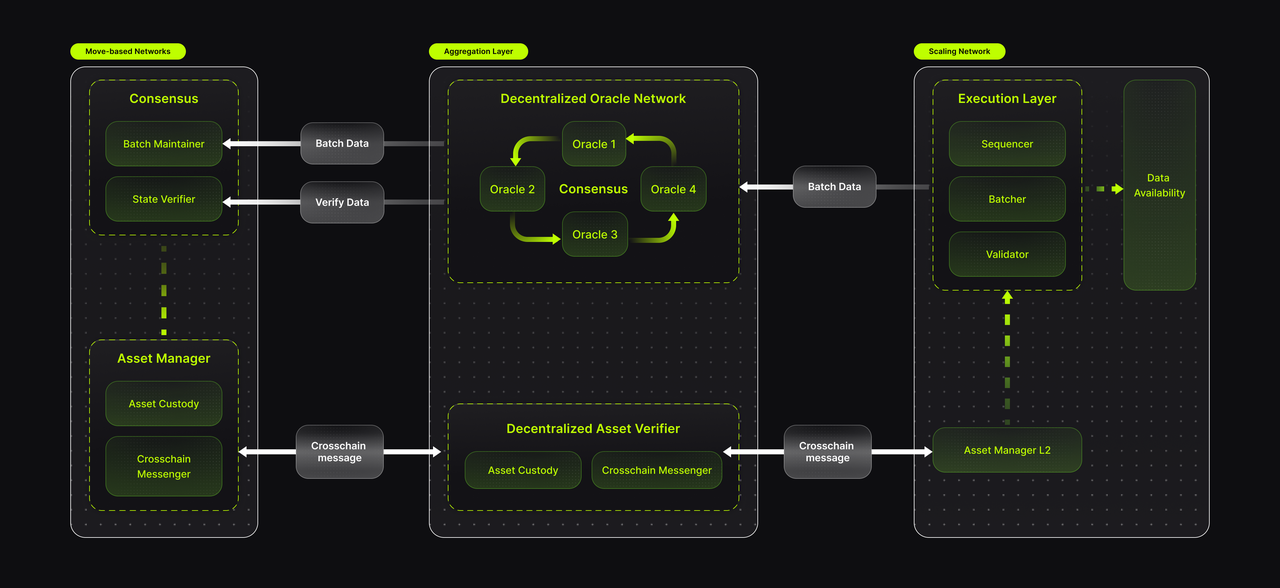and the distribution of digital products.
Lumoz RaaS Introduces Layer 2 Solution on Move Ecosystem
\ Abstract: By offering full EVM compatibility, Lumoz RaaS enables Ethereum-based projects to seamlessly integrate into the Move ecosystem, including networks like Sui, Aptos, and Movement. The solution not only facilitates cross-chain collaboration and unlocks new growth opportunities but also lowers transaction costs and enhances user experience. Lumoz RaaS provides developers and enterprises with a smooth, efficient pathway into the Move ecosystem, driving innovation and fostering sustainable development across multiple blockchain networks.
IntroductionLumoz’s Rollup-as-a-Service (RaaS) now supports scalable Layer 2 networks within the Move ecosystem. This solution leverages the resource-oriented Move programming model, enhancing security through strict type systems and ensuring precise asset and data management. By integrating Rollup technology, it provides high-speed transactions, reduced gas fees, and full EVM compatibility, allowing Ethereum projects to seamlessly join the Move ecosystem.
\ With a modular three-layer architecture covering consensus contracts, data flow, and execution management, Lumoz ensures smooth cross-chain communication. It offers developers and enterprises new Web3 opportunities by enhancing performance, security, and interoperability.
Advantages of the Lumoz SolutionAs a Layer 2 network running within the Move ecosystem, Lumoz leverages the strengths of the Move programming language, including enhanced flexibility and security for data and asset management. Whether using MoveVM or customized versions like SuiVM and AptosVM, the resource-oriented model ensures safe and efficient handling of batch data and asset states, minimizing vulnerabilities during development.The Rollup-based RaaS solution further boosts network performance by increasing throughput, speeding up transaction confirmations, lowering on-chain interaction costs, and offering full EVM compatibility. Its proven Rollup consensus mechanism ensures that Layer 2 inherits the security of the Layer 1 network, providing robust protection.
\
Infrastructure of the Solution
\ Lumoz will adopt a three-layer structure to provide scalability solutions for Layer 1 networks based on Move, consisting of the following main levels:
\
Consensus and Asset Management Contracts on Layer 1: This part will utilize the features provided by the Move language, ensuring the security of assets and data in the scalable network through a resource-oriented modular design.
\
- Consensus: Core modules include a Batch Maintainer, which manages Layer 2 batch data, and a State Verifier that validates the status. The Layer 2 state is deemed valid only when the information in the Batch Maintainer is consistent with the State Verifier's validation.
\
- Asset Manager: Comprises Asset Custody, which manages the assets, and Crosschain Messenger, which handles cross-chain state. The Crosschain Messenger verifies the validity of cross-chain requests within the Consensus before Asset Custody processes the asset state.
\
Aggregation Layer: Serving as an intermediary between Layer 1 and Layer 2 networks, this layer is responsible for the bidirectional exchange of data and information, as well as cross-chain communication, laying the foundation for the security and interoperability of the extended network.
\
- Decentralized Oracle Network: Acting as a bridge for data and information, this layer uses independent network consensus to ensure that batch data and states submitted by the extended network can be confirmed by Layer 1, thereby enhancing system transparency and credibility.
\
Decentralization Asset verify Layer: This layer verifies the flow of cross-chain communication, including assets, between Layer 1 and Layer 2 networks. It enhances transaction security and liquidity by checking the validity of cross-chain requests and network states through proposal and review processes.
\
Extended Network: Composed of execution modules, cross-chain modules, and data availability modules within the Rollup architecture.
\
- Execution Layer: Serving as the direct entry point for transactions within the extended network, it executes, processes, and packages transaction data from Layer 2 while maintaining the network state. Once batch data is packaged, it is submitted to Layer 1 for validity verification according to Rollup consensus.
\
- Asset Manager L2: Corresponding to the Layer 1 Asset Manager, it initiates and processes relevant cross-chain requests and updates the asset state on Layer 2 based on validity verification results.
\
Data Availability: Stores the complete on-chain data produced by the execution layer, providing transparency and reliability for the network's data.
\
Through this three-layer architecture, Lumoz not only ensures high performance and security for the extended network but also achieves tight integration with Layer 1 of Move, providing users with a more efficient scalability solution.
\
ConclusionIn the increasingly competitive blockchain market, scalability has become essential. Lumoz's RaaS framework is set to be a key driver within the Move ecosystem. With its high performance, security, and low-cost features, RaaS provides compelling reasons for enterprises and developers to adopt Move's Layer 2 solutions. By simplifying the transition between Ethereum and Move ecosystems and enabling seamless cross-chain interactions, Lumoz lays the groundwork for the evolution of decentralized ecosystems.
\ The successful launch of Lumoz RaaS in the Move ecosystem reflects ongoing technological advancements and support for multiple major blockchain ecosystems, including BTC, ETH, SUI, and TON. This innovation enhances interoperability and fosters the future of the Web3 ecosystem.
- Home
- About Us
- Write For Us / Submit Content
- Advertising And Affiliates
- Feeds And Syndication
- Contact Us
- Login
- Privacy
All Rights Reserved. Copyright , Central Coast Communications, Inc.